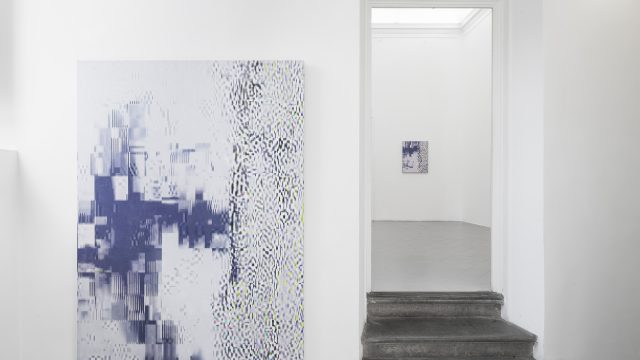On the occasion of my visit to John Isaacs’ exhibition ‘Only Words’ at Aeroplastics Contemporary I had the chance to meet the artist and engage in a conversation about his work, his career, and his thoughts on contemporary art. The result of this dialogue is the following transcription.
John Isaacs is a British artist born in 1968 who lives and works in Berlin. Isaacs has exhibited in well-known institutions and galleries such as Tate Britain, Lisson Gallery, Saatchi and Serpentine. If you Google John Isaacs you most certainly get acquainted with works that revolve around the aesthetics of the body and the flesh – obese deformed bodies, severed legs, detached shark fins. However, the scope of his work is unveiled with this conversation and during the course of this exhibition, where Isaacs guides me through the idiosyncrasies/intricacies of each work and talks about his career and background.
John Isaacs: When people ask me what I do I say I am an artist, but sometimes I say… I am not really an artist. It has something to do with being in the middle of a story. Genuinely, for me, the point of my artistic production is not technicality; it is a form of healing and philosophy. That is also why the works are very different. A lot of the shows I do don’t look like a solo exhibition, they look, instead, like a curated group exhibition. This is a form of anonymity, but it is also a form of, in a way, anti-art.
And indeed the show ‘Only Words’ presents works in diametrically opposed techniques as in neon, bronze, terracotta, and photography.
It is a characteristic of Isaacs’ work to complete each piece with an evocative title. Each individual piece addresses a question, but the artist says it is key to place works together, to create analogies and dialogues by which new meanings are found. Historical and artistic references are to be discovered along this exhibition.
By the entrance, a terracotta hand points to an abstract neon compass (as Isaacs explained, it was created based on one of his daughter’s doodles). Right there, an initial clash of aesthetics (the contemporary and industrial aspect of the neon face to face with a seemingly historical relic). The hand – ‘The cyclical development of stasis’ – with a strong pointing gesture (either accusatory or didactic, a gesture that has permeated our culture and collective memory) is enclosed in a vitrine. In effect, this contemporary object simulates an artefact that somehow appears to have spent years submerged in deep sea water. John Isaacs told me about the curious incident that led to the materialization of this hand and how it became an illusory museum piece:
JI: Actually, when I modelled it that wasn’t the initial intention, because I modelled the whole hand, but during the firing process in the oven it exploded. I was on the verge of throwing it away, but then I realised I could use the pieces and restore this object. The whole idea of vitrine is an important aspect of it. In a way, this is me as a contemporary artist trying to play like a museum, like an archive or archaeological find. I modelled the hand in terracotta, which is a very traditional sculpture material from Roman/Greek times. That is also why it has these casts on it looking like an amphora. My intention was to hope that people would look at it and have the sense that this is an artefact from thousands of years.

This work and its title (‘The cyclical development of stasis’) open the tone of this exhibition that is a journey in the conscience of an historical and cultural past, of the political and social tensions of the present and a slight hope for the future – although history reveals itself to be cyclic and static. This idea is also preponderant in the exhibition’s title ‘Only Words’. Isaacs’ work is not about activism nor the artist promotes a thesis or solution. It doesn’t ask for a passive and contemplative attitude either. The exhibition is made for the viewer (who is sometimes included and reflected in the artwork) and aims to raise questions.
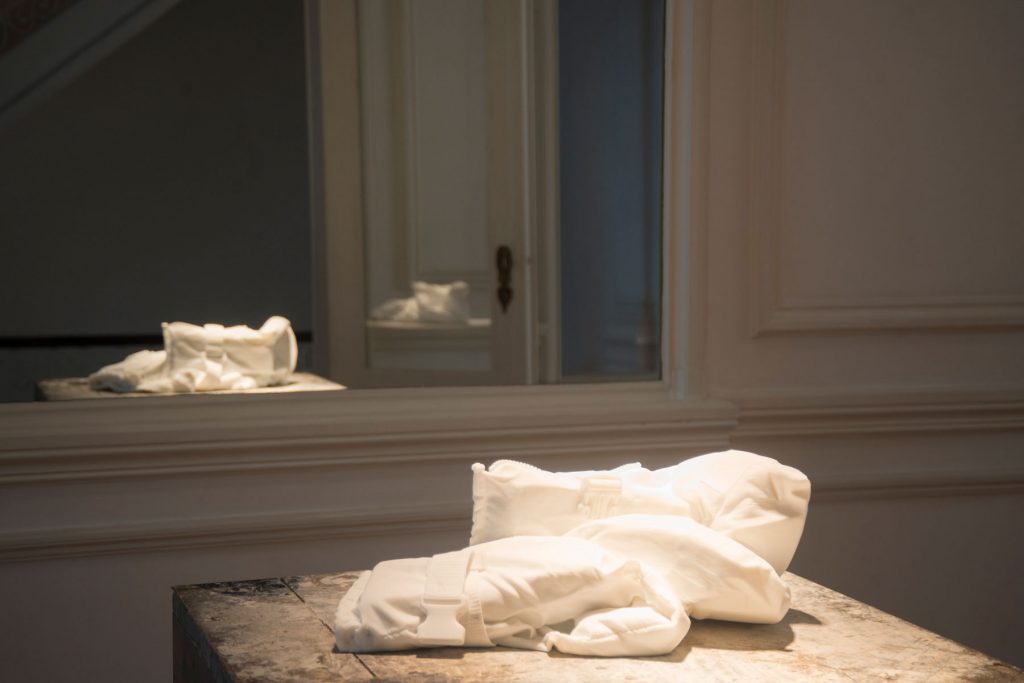
child size life jacket in statuario marble, wood, steel, 109 x 70 x 74 cm. Courtesy Aeroplastics contemporary, Brussels.
‘The architecture of empathy’ is a small size life jacket carved in marble and placed in front of a mirror. This work is an example of the inclusion of the viewer, thereby faced with current political and moral issues. John Isaacs talks about this work and the importance of another work with the same title (which is not included in this exhibition):
JI: This sculpture, of course right now, seems to be a comment on the refugee crisis.
CV: Was it made in that context?
JI: Yes. But the title of the work is ‘The architecture of empathy’. Though new stories happen, the world moves on and things change, but then a similar moment occurs in some other country or some other situation. This idea of sailing alive is something from beyond this moment of the refugee crisis. This sculpture comes from another work that I’ve made a few years ago with the same title (‘The Architecture of Empathy’). This is Pietà covered in fabric, which is also carved in marble. I don’t make it, this is done by artigiani in Carrara, the traditional place for making marble. I make the model and they work from that. The first sculpture, Pietà, was for me an attempt to bring this notion of empathy out of the church and back into the world. Because the church is saying one thing, but it makes people behave in a different way.
CV: But the figure is covered…
JI: Yes, because I chose to give it no identity, which happens quite often in my work. There is no physical representation of people because then it’s the other, it is not possible to project into it. By covering this figure, which you can even recognize with the covering on, you see this connection with the mother and the child and then it takes it away from the Madonna and Jesus and brings into all these images we know… of conflict, but also when people die and you have these sheets over the furniture. By covering this icon of empathy I am giving it a rebirth because, in classical marble sculpture, the way the drapery was used was not to cover the body, but to emphasize it. The drapery represented the spirit and the body was the flesh, the carnal (like the meat key upstairs). My feeling, my intention is that these foldings, this transformation of stone into this soft fabric-like quality, transform it into a kind of spiritual object.
CV: Like the matter referred to as ectoplasm?
JI: Yes. It is as heavy as stone, but it has this lightness. And again, the viewer fills in the rest of the story because there is no human representation, so it is open to everybody. It is a child’s life jacket because it is too small. It is also a theme that seems to be in this exhibition not necessarily on purpose (the compass, the chair, this work). There are a few works that give this sense of origin and of course children represent the future, but they also represent vulnerability, they need protecting, and the people that protect them aren’t always the best people to do that. Again, like I was saying earlier, there is this sense of damage that is done and the impact it has in the future. I am coming from the past because we all grow up into a world in which maybe some of the shadows in it are not of our asking.
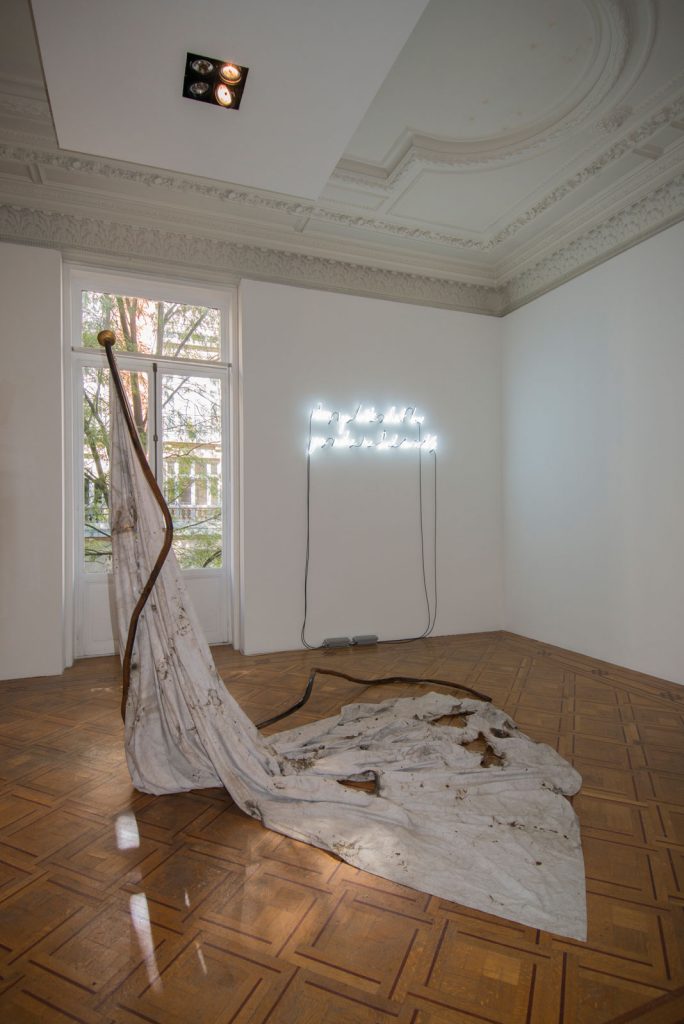
In the next room we find ‘Inconsolus (when you talk about love)’ and ‘This is the place’ (a giant damaged white flag resembling a tent, a boat, and an “act of surrender”). ‘Inconsolus’ is a neon sentence taken from a poem written by the artist – “when you talk about love you make me feel invisible”. These two works positioned near ‘The Architecture of Empathy’ establish a correlation and acquire a political sense:
JI: After having it read for a while, I found that these two lines had the right kind of sentiment. And again it’s this double thing because it has a kind of political level – how quite often a lot of us feel in the face of the so-called democratic process, its lies. This work, which is actually from a poem, has this very personal possibility, and a very politicized possibility, and is now even more thrown in that direction.
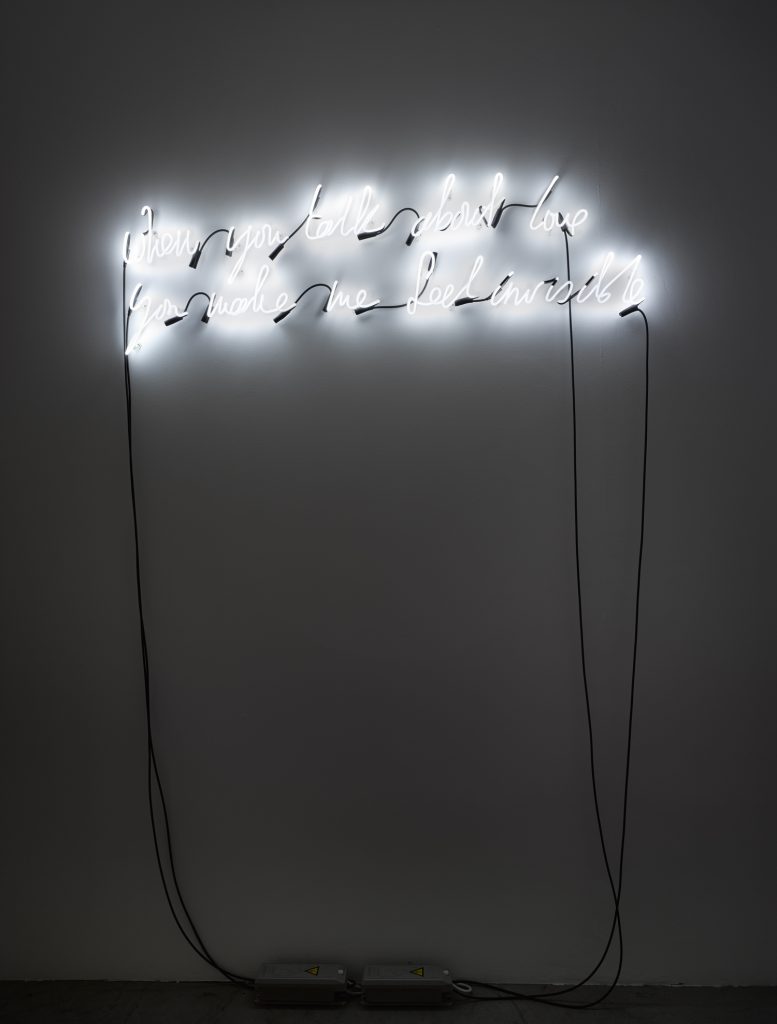
The idea of vulnerability is present in most of John Isaacs’ body of work and is explicit in this exhibition – it subtly surfaces through the fragility of the material or in references to childhood. On the second floor we find ‘Votes for Children’, a slogan written over stitched fabric, bordering both absurdity and hope.
JI: I can’t remember how or why, but there’s a book about the 100 favourite objects in the British Museum collection, done by the director of the British Museum in London. In this book there’s a British coin from 1912 that stamps ‘Votes for Women’. Women in England were stamping this propaganda onto money and putting it back into circulation. This was a very clever way of propaganda in 1912. [Talking about ‘Votes for Children’] I like these fabric banners, traditionally made by the ‘low ladies’ or people like coal miners. The pattern on the front came from a Polynesian shield. The slogan ‘Votes for Children’ is again a kind of double thing – ‘how you like me full of hope and full of fear’ situation. The idea of children voting would be like in Lord of the flies, a book by a British author in which an airplane full of schoolchildren crashes on an island and after a few weeks someone becomes a leader and someone else wants to be leader. Within two or three weeks these boys split into two tribes and they start fighting each other. In the end, human nature is such that even children can’t share a toy. They are maybe no better than us. We have consumed the present to give nothing for the future. This is a kind of naïve hope, but also in a way, like the life jacket downstairs in front of the mirror, we all are implicated. So it’s a big question, but it is not political propaganda.
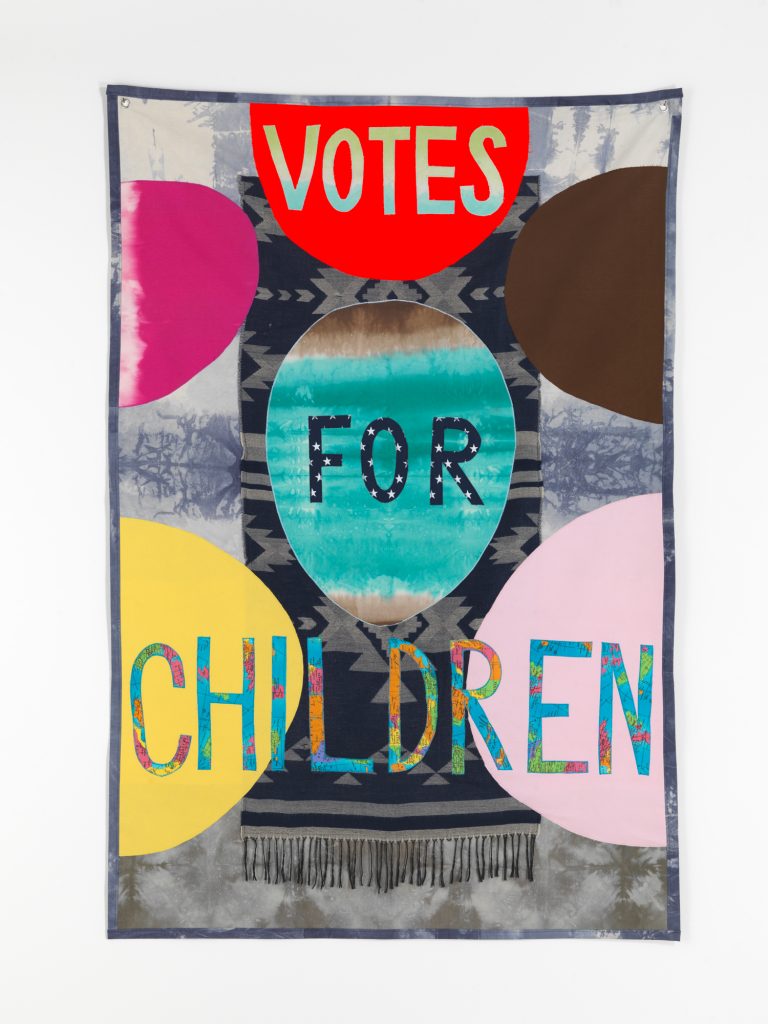
Again, in the next room, while looking at ‘Cast from light and dark your shadow is no different from mine’ I noticed it was a children’s chair made of bronze. Although the reference to children is present here again, John Isaacs explains that what makes this sculpture (and other sculptures) so vulnerable is the choice of material – bronze.
JI: It’s again another attempt to try to bring this sense of commonality and History. In the end, simply the chair is a child chair, but in my mind it is like an anchor. This idea of childhood being the foundation of our psyche (which is the anchor) has nothing to do with childhood slavery. I have a few of these bronzes. What is interesting for me, not necessarily in this sculpture, but in the other bronze pieces that I’ve made, is that people make this mistake – they look at bronze and think it is a very strong permanent material, but, politically it is very mercurial. It’s like quicksilver. The only classical bronzes we have only survived because they were hidden. People who don’t give a shit about art would melt the bronze and turn it into cannons or nails. People look at a bronze sculpture and they think it’s made of bronze so it will be like that forever, but it’s not the case. It exists as long as people believe in it. One of the most powerful images that I have seen recently is the one of the statue of Saddam Hussein being pulled down by the American soldiers when they invaded Iraq. You think of all these dictators and these hundreds of Lenin and Stalin sculptures all over Russia and they are now obsolete. Bronze is not permanent. This could be heated up and you could make another shape out of it. I like the significance of the material. If it was a wooden chair it would have a completely different meaning.

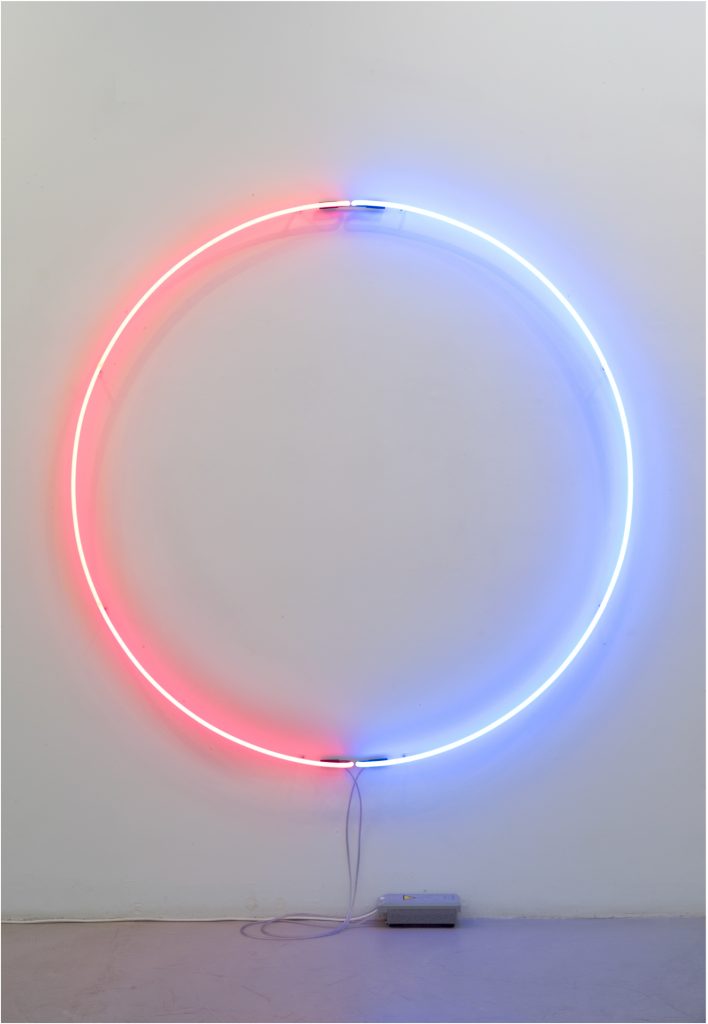
In this room we find another neon light. This time a simple, minimal, circular shape – a bit unusual in John Isaacs’ work – half blue, half red – ‘Blood and Tears’. What is not so unusual is the evidence of the body and flesh, which this time turns up to be shaped like a giant meat key – ‘Everything given nothing lost’.
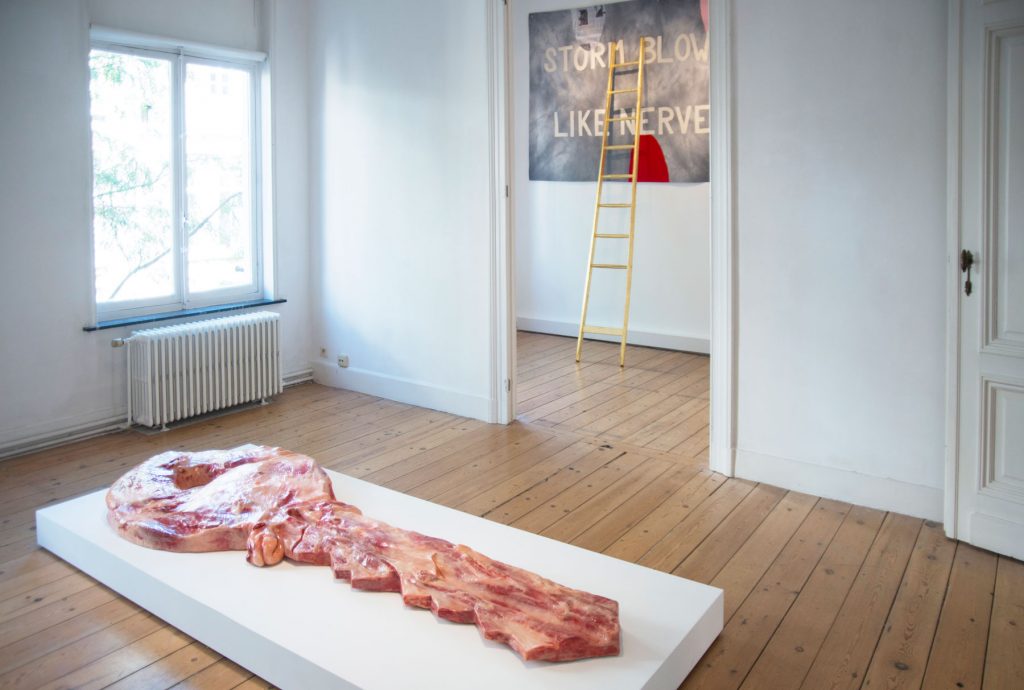
Perhaps the most intriguing works in this exhibition are two of his most recent creations. ‘The unseen structure’ is again an illusory relic or archaeological discovery – an anthropomorphic stone figure, with traces of eyes and nose, on which seven golden eggs are piled up. Behind the sculpture, but part of it, we find a small steel door. Enclosed in a small dark room and under a spotlight, this structure/creature becomes even more theatrical and mysterious. John Isaacs plays with notions of time and history and challenges the viewer to discover what is created by the artist and what is a historical finding. Isaacs demystified this work and explained how it was created.
JI: It is ceramics. I made this to look like an old oven, like this object needs sustaining. I started the eggs for another piece, which I did not finish. The underneath piece was an accidental discovery while I was doing some research in this exhibition (in London) about Stanley Kubrick the filmmaker. I was in his archive looking through material and there was this book about minimal forms and then there was a small Neolithic figure, two eyes and this nose, a very simple form. I just started it in clay and slowly came to be this. I am not sure what it is, what it represents, but it has got a very odd aura to it. And there is a mysticism – seven eggs, seven days. They almost have a planetary feeling. In my work there is this sense of déjà vu. I am quite often using clichés.

Some of the artist’s works have an encyclopedic character, which could be related to his background in science. Moved by his curiosity, Isaacs develops a constant research of historical facts, literature, and cultural studies that allows him to create associations of images that are etched in our memory (which makes me think of Aby Warburg’s investigation and atlas – ‘Mnemosyne’). Isaacs is not afraid to entrust his viewers with his most recent works, in the sense that he wishes them to be put to test, curiously listening to the viewer and absorbing their interpretation and questions. ‘What makes certain’ is one of these works, conceived just before this particular exhibition. Again, a sentence over stitched fabric (‘Storm blown sea calmed like nerves on the edge again’), with a fragile looking golden ladder leaning over it, finds its way to proclaim the already mentioned vulnerability existent across this exhibition and to bring to surface the idea of cycle and chain.
JI: I am fascinated by this sentence that is going in so many directions. I can’t even remember where it came from. I am sure I wrote it, but it could be like the Aby Warburg verbal collective memory, because I don’t even know if I am able to write something like this. I think it is in one of my sketchbooks. There is something about these words, which is almost like war, almost like the threat of war, almost like love. It’s like this feeling of passion, danger, and fragility.

John Isaacs has his eyes open to the world – as a scientist, he analyses political, historical, anthropological facts, he collects ideas (from an archive or in the simple interactions of life with his daughter), and, above all, he is a concerned human being who translates into images the frailty of being in a world dominated by words. I believe the most permanent question in this exhibition is – Is there any hope in stasis?
JI: I think for me this idea of being historical, of being anonymous, (and this is something that fascinates me not just in art but in life) is this sense that we are born into a landscape, which is already formed; we learn a language, which is already there, and the world is built on a way that maybe we didn’t intend it to be. We are walking in the shadows of our ancestors and so something like this for me is a kind of cathartic idea of where we are, where we were, and where we will be. This is stasis, static.
By: Catarina Vaz



